Alaska has excellent fishing, amazing views of the Northern Lights, and exceptional caves. The state is rich in minerals, limestone, and rainwater, which causes this extraordinary process that forms unique cave types. Caves outside of Alaska might seem dark and dreary, but inside this state, caves look much different.
Many caves are formed from glaciers melting and refreezing during the summer and winter. If you’ve ever wanted to see such amazing feats, you’re in for a treat. You can find guided tours of these caves with amazing views and fun surrounding activities.
So, let’s get into discovering these 15 amazing caves in Alaska!
1: Mendenhall Ice Caves
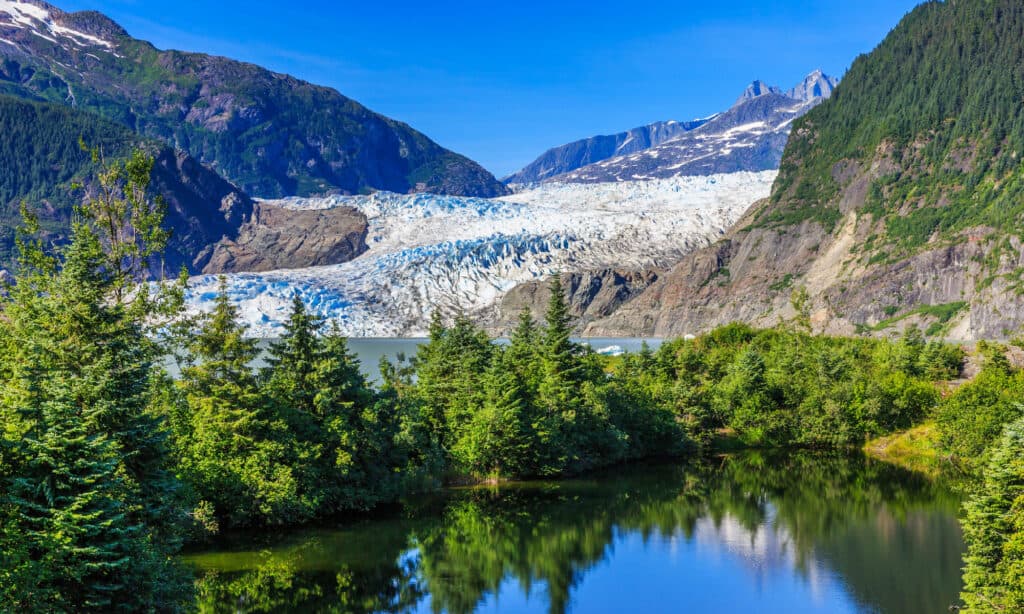
The Mendenhall Glacier has multiple caves that visitors can explore. However, they are best viewed during the summer months in good weather.
©iStock.com/SCStock
Mendenhall Glacier spans 13.6 miles and is inside Mendenhall Valley. It’s home to some of the most stunning ice caves you’ll ever see. Initially, the glaciers were the Tlinkit Sitaantaagu, which means Glacier Behind the Town, or Aak’wtaaksit, Glacier Behind the Little Lake.
The glacier is home to some of Alaska’s most amazing yet treacherous caves. If you plan to visit, you will need to book a tour, as to get to the Mendenhall Ice Caves, you will need to trek across Mendenhall Glacier. This hike is slippery and extremely dangerous, especially in certain weather conditions.
Inside the cave, there are beautiful blue ice formations that are breathtaking. Each ice formation has this cloudy look, reflecting any light off the walls. While stunning, the ice inside the caves constantly shifts, which can be dangerous but worth it if you are with a guide.
You can get to the caves in two ways. A 20-minute drive from Jeanue, Alaska’s capital, or hiking through Tongass National Forest for eight miles. Both are excellent activities, as you get to explore the surrounding beauty of Alaska and its glaciers.
2: Matanuska Glacier Cave
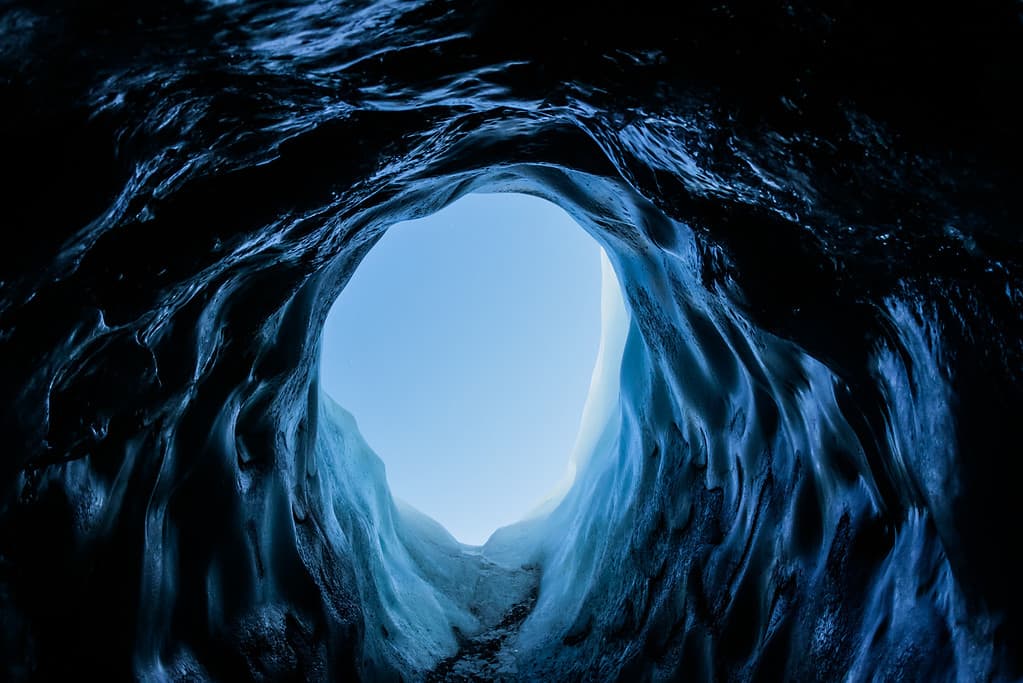
Caves on the Matanuska Glacier are extremely dangerous but worth the trip if done with a professional.
©DCrane08/iStock via Getty Images
The Matanuska Glacier is the most loved of all the caves in Alaska. It spans over 27 miles and is four miles long with some fantastic views. Viewing the caves is only available via tour. The glaciers are extremely dangerous and slippery. Plus, some caves go through inspection and are straightforward to help make the journey safe.
Unlike the previous caves, these are light blue, white, and black hues. The walls of the caves are thick and lustrous, while the floors have the Matanuska glacier underneath. Other caves tend to reflect the light, and the Matanuska caves keep a deep blue color throughout. It’s a stunning sight, and the company is constantly finding new areas of the glacier to tour.
Luckily, It’s only a two-hour drive from Anchorage, the state’s central hub. Visitors can schedule a tour online and pay. Then, they can meet their tour guide at the location and hike up the glacier into the caves.
3: Spencer Glacier

The mere height of Spencer Glacier results in some unique caves that are exceptionally deep.
©DCrane08/iStock via Getty Images
Spencer Glacier is a unique destination even for Alaskans due to its intimidating 3,500-foot rise. Located in Chugach National Forest, the Spencer Glacier is one of the favorites for ice hikers who want a challenge. The trek can be done either alone or by hiring a tour guide.
Here, the ice caves are what you would consider meltwater. Meltwater is a fancy word to describe ice caves that have melted water from the surrounding glaciers. The melting ice in Spencer Glacier trickles through the caves and creates these stunning blue ice walkways. Inside, you’ll hear bits of running water as the glacier’s meltwater constantly forms the cave.
The glacier is 60 miles south of Anchorage, a few hours’ drive. The trip is somewhat tedious, as you’ll have to follow alongside mountain pathways to get there. It might be impossible in winter, as the surrounding areas tend to be very steep and have plenty of falling snow.
4: Zina Cave

Tongass National Forest covers 500 miles of southeastern Alaska.
©iStock.com/ad_foto
Tlacatzinacantli, which translates into “bat god,” is a cave inside the Tongass National Forest in Southeastern Alaska. The cave is on Prince of Wales Island, one of over 600 caves. What sets this cave apart from others is that it’s the oldest cave in the state’s southeastern region.
The cave’s opening is a small tunnel into which animals can fit. Inside the cave are multiple tunnels branching off from the main entrance. A large river can be found at the cave’s depths.
5: Hole 52 Cave

Natural trap caves can be found all over the Tongass National Forest.
©Nicola Borrani/Shutterstock.com
Hole 52 Cave is located inside the Tongass National Forest on Kupreanof Island. It’s a natural trap cave that traps anything that falls into it. The cave was discovered in 1998 by scientists who found animal remains.
The cave is very narrow and has lots of horizontal passages within. Inside are vertical pits, which can be very dangerous. Animals like bears and porcupines travel into the cave and get stuck in the vertical pits. Therefore, it’s advised to be cautious when exploring in and around the cave.
6: Puffin Grotto

Ice caves can be found across Cape Addington, especially in the mountainous areas.
©Danita Delimont/Shutterstock.com
Puffin Grotto is one of the more desolate ice cave locations in Southeast Alaska. It’s a part of Noyes Island near Cape Addington and is a stunning sight. The entranceway is spectacular and can be seen from miles away. A trip by boat is the only way to get to the cave. Puffin Grotto Cave gets its classic name due to all of the cute puffins nesting around the openings of the caves.
7: On Your Knees Caves
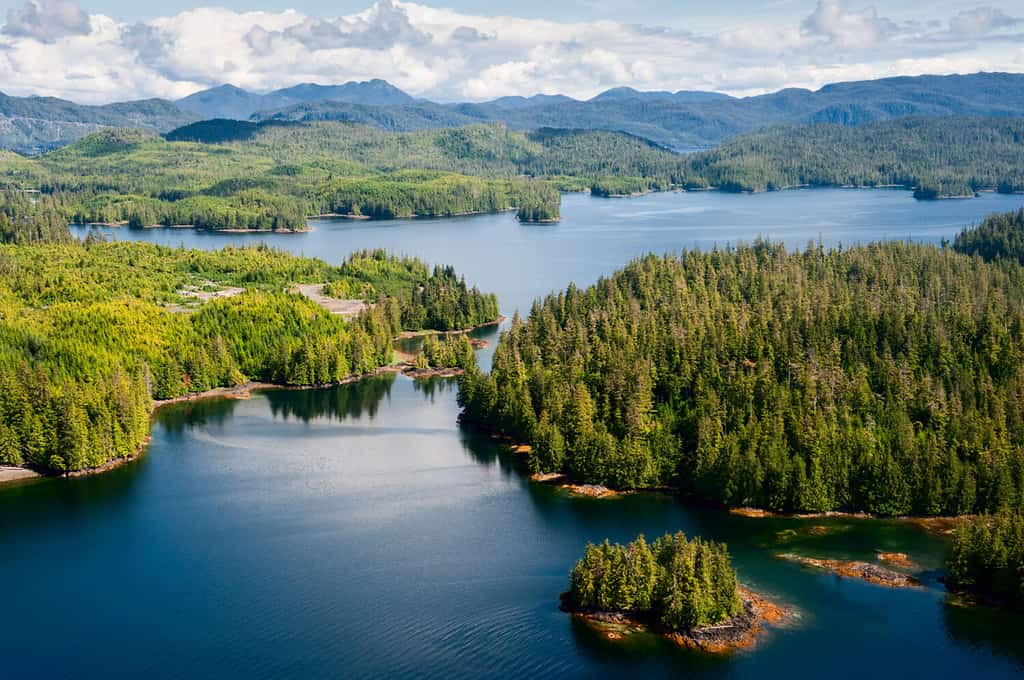
Prince of Wales Island has many small cave systems located throughout its forest.
©Andrea Izzotti/Shutterstock.com
On Your Knees Cave (OYKC), also known as Shuka Kaa, which translates into “Man Ahead Of Us,” is located on the northern end of Prince of Wales Island. Its specific location on the island is on Protection Head and is a popular place for outdoor activities.
The OYKC is an archeological site that holds the Tlingit clan’s cultural and spiritual artifacts. Dr. Timothy Heaton excavated the cave in 1996, discovering human remains, animal bones, stone tools, and more. To this day, the cave is a popular place for archeologists and paleontologists.
8: Kushtaka Cave

Paleontologists favor Kushtaka Cave for the animal remains present there.
©vagabond54/Shutterstock.com
Kushtaka is a Tlingit word that translates to “Land Otter Man,” a name for shape-shifting creatures that resemble a man and an otter. The cave is on the east side of El Capitan Passage on Prince of Wales Island.
Visitors must crawl through the small opening before opening to a bigger area. Plenty of animal remains are located throughout the cave, making it favored by paleontologists. Aside from that, the cave has a wealth of geological history, making it popular for geologists and spelunkers.
9: Bumper Cave

Brown bears roam the area around Bumper Cave.
©Alaska Drones/Shutterstock.com
Bumper Cave is a smaller cave on Calder Mountain in Point Baker, AK. There are much bigger caves on Prince of Wales Island, and Bumper Cave is drastically smaller than others. However, it has been a popular area where brown bears roam. We know this due to the remains that are found inside the caves. Visitors can explore the caves famous for spelunking, hiking, and more.
10: Devil’s Canopy Cave
Devil’s Canopy Cave is on Prince of Wales Island. The cave is a part of the Karst hydrologic complex, a landscape created by acidic waters eroding porous rocks. The cave is known as the Devil’s Canopy due to a plant canopy outside the cave entrance resembling a trap, giving the cave an ominous look.
The surrounding canopy of plants outside the cave contributes to its danger. Visitors must watch for the stream that flows into the cave, as it can cause people to slip. Animals and people have fallen due to the excess foliage.
11: El Capitan Cave

Reaching El Capitan Cave can be difficult, but stairs and ramps have been installed.
©vagabond54/Shutterstock.com
The El Capitan Cave, commonly known as El Cap by locals, is in Naukati, AK, inside the Tongass National Forest. Currently, El Capitan Cave is known as the longest cave in the state, spanning over two miles. It’s a popular destination for those who want to explore caves, as it is a geological treasure that existed for more than 400 million years.
Visitors are allowed inside the cave for tours that last two hours. At first, the beginning of the cave is accessible to trek and often is a great place. However, the further inside the cave you go, the rougher the terrain. Due to this, tours are halted at the 500-foot mark to prevent injuries.
12: Kit’ n’ Kaboodle Cave

Tongass National Forest covers 500 miles of southeastern Alaska.
©iStock.com/ad_foto
Kit n Kaboodle Cave is located in Gold Harbor on Dall Island and is protected by federal law. It’s another cave inside Tongass National Forest that was first discovered in 1992 by the USDA Forest Service.
The cave Kit’ n’ Kaboodle is an archaeological site known for its fossils. Many scientists and archaeologists have discovered numerous types of plants and animal fossils inside the cave. Paleontologists and biologists
The site is part of a complex solution cave system inside limestone bedrock. Now, the cave has multiple entrances, levels, and passageways. The cave produces sounds of water trickling within the cave, which echoes to the outside.
13: Blowing in the Wind Cave
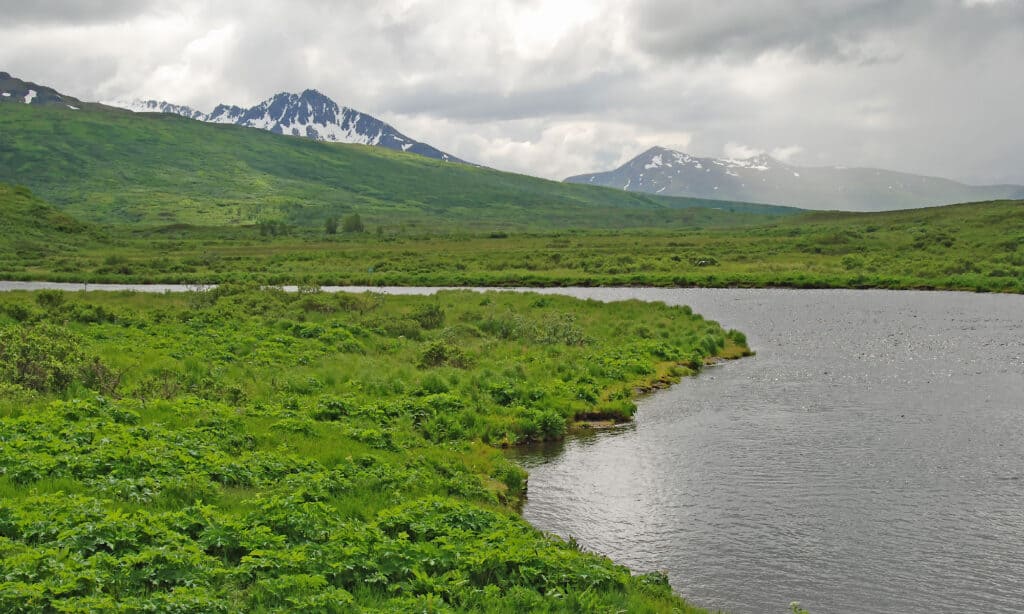
Kodiak Island consists of mountainous regions, forested areas in the north and east, and lowlands in the south.
©iStock.com/Wildnerdpix
The Blowing in the Wind Cave is near El Capitan Cave on Kodiak Island. Despite it looking like a regular cave, it produces a unique “breathing” sound due to barometric pressure. This creates an unusual gust of air that blows throughout the cave. The traveling air causes a breathing or howling effect that echoes to the entrance.
14: Trail Creek Caves
The Trail Creek Caves are a system of 12 connected caves in the Bering Land Bridge National Preserve on the Seward Peninsula. They were discovered in 1928 by Taylor Moto and Alfred Karmmun. They found multiple archeological artifacts, including tools from ancient hunters and bone fragments dating back over 8,500 years.
15: Root and Kennicott Glaciers
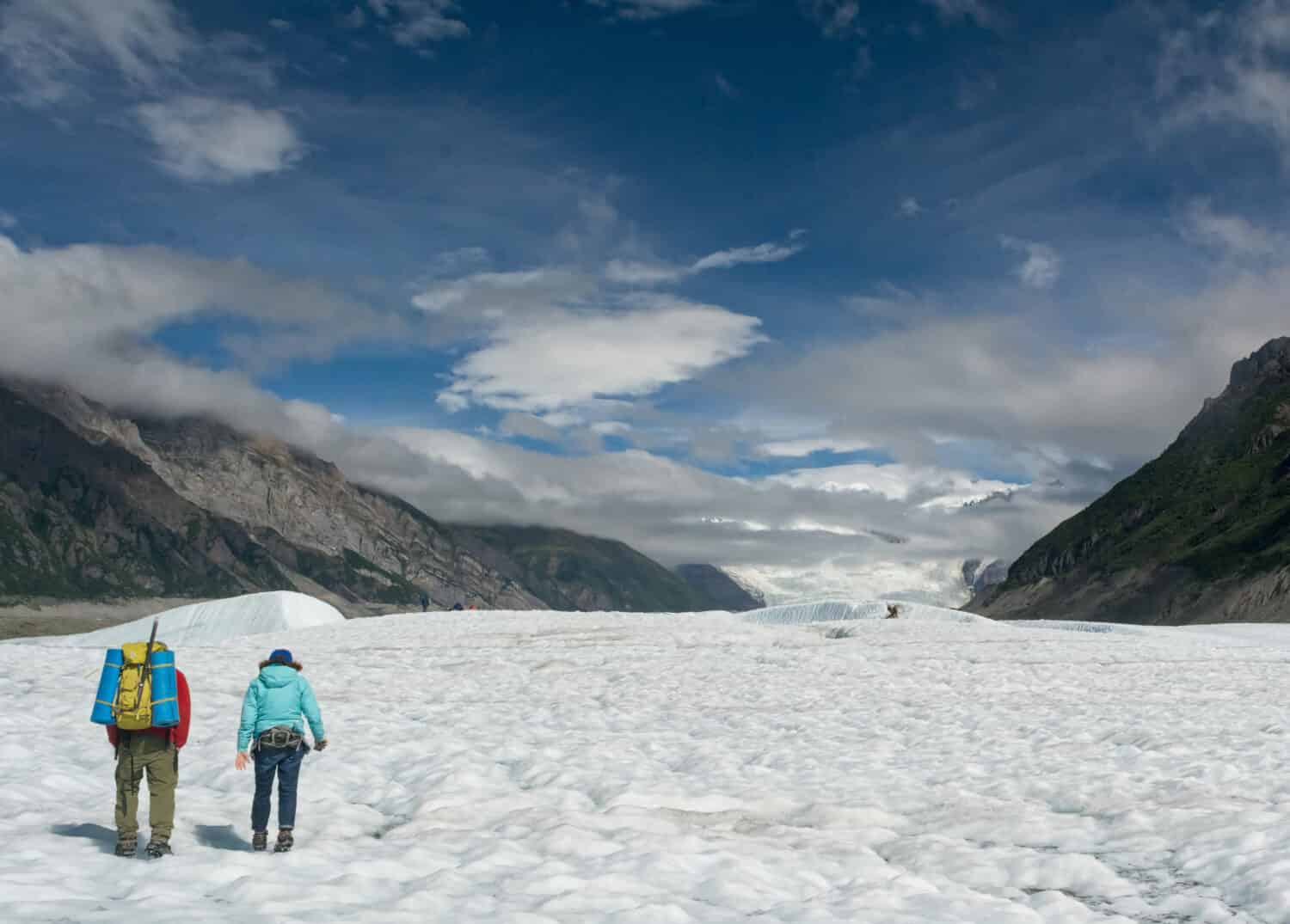
Tours are a requirement to visit the dangerous cave at Root Glacier.
©Jon C. Beverly/Shutterstock.com
The Root and Kennicott Glaciers are located in Wrangell-St. Elias National Park and Preserve have the most impressive caves. The Root Glacier spans more than 5,000 square miles and features tours. These caves are constantly warping and changing due to the glaciers.
Treks inside the cave can be dangerous, so you must book a tour. Each tour will provide you with the necessary equipment needed to help keep you safe.
Summary Caves in Alaska
| Number | Cave |
|---|---|
| 1 | Mendenhall Ice Caves |
| 2 | Matanuska Glacier Cave |
| 3 | Spencer Glacier |
| 4 | Zina Cave |
| 5 | Hole 52 Cave |
| 6 | Puffin Grotto |
| 7 | On Your Knees Caves |
| 8 | Kushtaka Cave |
| 9 | Bumper Cave |
| 10 | Devil’s Canopy Cave |
| 11 | El Capitan Cave |
| 12 | Devil’s Canopy Cave |
| 13 | Blowing in the Wind Cave |
| 14 | Trail Creek Caves |
| 15 | Root and Kennicott Glaciers |
The photo featured at the top of this post is © DCrane08/iStock via Getty Images
Thank you for reading! Have some feedback for us? Contact the AZ Animals editorial team.







